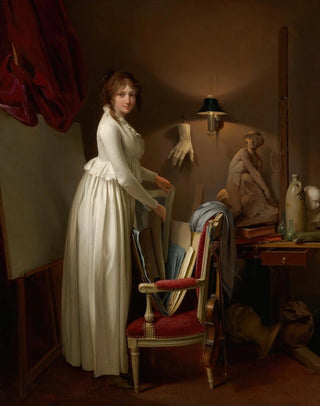Art print | The artist's wife in her studio - Louis Léopold Boilly


View from behind

Frame (optional)
In a world where light and shadow dance across the canvas, "The artist's wife in her studio" by Louis Léopold Boilly immerses us in the creative intimacy of a frozen moment. This iconic work, created in the early 19th century, offers a fascinating glimpse into the artistic universe of its time. The artist, a prominent figure of the neoclassical movement, invites us to share a moment of contemplation, where the woman, muse and companion, becomes the reflection of the artist's aspirations and struggles. Boilly, through this intimate scene, manages to capture not only the beauty of his model but also the very essence of artistic creation.
Style and uniqueness of the work
Boilly's style is distinguished by his ability to combine realism and sensitivity. In this piece, meticulous details and a subtle palette reveal impressive technical mastery. The light filtering through the studio window creates a warm and enveloping atmosphere, while the delicate expressions of the characters testify to a deep emotional connection. The composition, skillfully orchestrated, highlights the artist's wife, who, while being the main subject, also seems to symbolize creative inspiration. The elements of the studio, carefully arranged around her, emphasize the artistic process and the pursuit of beauty that drives the artist. Thus, this work transcends a simple portrait to become a celebration of art and life.
The artist and his influence
Louis Léopold Boilly, born in Paris in 1761, played a crucial role in the development of portraiture and genre painting during his era. Influenced by the great masters of the past, he infused a modernity into his works by incorporating elements of daily life into his compositions. His ability to capture fleeting moments and authentic emotions made him a pioneer in portrait art. Boilly was also a keen observer of the society of his time, and his works reflect the cultural and social changes that marked the end of the 18th century and the beginning of the 19th century. By depicting scenes of bourgeois life, he

Matte finish

View from behind

Frame (optional)
In a world where light and shadow dance across the canvas, "The artist's wife in her studio" by Louis Léopold Boilly immerses us in the creative intimacy of a frozen moment. This iconic work, created in the early 19th century, offers a fascinating glimpse into the artistic universe of its time. The artist, a prominent figure of the neoclassical movement, invites us to share a moment of contemplation, where the woman, muse and companion, becomes the reflection of the artist's aspirations and struggles. Boilly, through this intimate scene, manages to capture not only the beauty of his model but also the very essence of artistic creation.
Style and uniqueness of the work
Boilly's style is distinguished by his ability to combine realism and sensitivity. In this piece, meticulous details and a subtle palette reveal impressive technical mastery. The light filtering through the studio window creates a warm and enveloping atmosphere, while the delicate expressions of the characters testify to a deep emotional connection. The composition, skillfully orchestrated, highlights the artist's wife, who, while being the main subject, also seems to symbolize creative inspiration. The elements of the studio, carefully arranged around her, emphasize the artistic process and the pursuit of beauty that drives the artist. Thus, this work transcends a simple portrait to become a celebration of art and life.
The artist and his influence
Louis Léopold Boilly, born in Paris in 1761, played a crucial role in the development of portraiture and genre painting during his era. Influenced by the great masters of the past, he infused a modernity into his works by incorporating elements of daily life into his compositions. His ability to capture fleeting moments and authentic emotions made him a pioneer in portrait art. Boilly was also a keen observer of the society of his time, and his works reflect the cultural and social changes that marked the end of the 18th century and the beginning of the 19th century. By depicting scenes of bourgeois life, he






